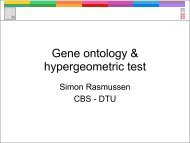Computational tools and Interoperability in Comparative ... - CBS
Computational tools and Interoperability in Comparative ... - CBS
Computational tools and Interoperability in Comparative ... - CBS
You also want an ePaper? Increase the reach of your titles
YUMPU automatically turns print PDFs into web optimized ePapers that Google loves.
Fig. 5 BLASTatlas of Clostridium botul<strong>in</strong>um F stra<strong>in</strong> Langel<strong>and</strong>: Lanes show genome homology of (start<strong>in</strong>g from the outermost lane):<br />
C. acetobutylicum ATCC 824, C. beijer<strong>in</strong>ckii NCIMB 8052, C. botul<strong>in</strong>um A str. ATCC 19397, C. botul<strong>in</strong>um A ATCC 3502, C. botul<strong>in</strong>um A str. Hall,<br />
C. difficile 630, C. kluyveri DSM 555, C. novyi NT, C. perfr<strong>in</strong>gens ATCC 13124, C. perfr<strong>in</strong>gens SM101, C. perfr<strong>in</strong>gens str. 13, C. tetani E88,<br />
C. thermocellum ATCC 27405, <strong>and</strong> Clostridium phage c-st genome. Inside of the annotation circle are shown global direct repeats, global <strong>in</strong>verted<br />
repeats, stack<strong>in</strong>g energy, <strong>and</strong> percent AT. Blue <strong>and</strong> red annotations are cod<strong>in</strong>g sequences on plus <strong>and</strong> m<strong>in</strong>us str<strong>and</strong>, whereas green <strong>and</strong> turquoise<br />
are rRNA <strong>and</strong> tRNA, genes respectively. The two tox<strong>in</strong> components NTNH <strong>and</strong> BoNT/A1 that are identified on phage c-st are present <strong>in</strong> the<br />
reference genome at positions 880 kb <strong>and</strong> 883 kb, respectively (marked ‘cst’). The presence of the two is visible as a th<strong>in</strong> blue b<strong>and</strong> on the c-st blast<br />
lane. The lower part of the figure shows a zoom of the region around 2635 kb, provid<strong>in</strong>g an example of a gene cluster which appears to be<br />
conserved throughout the C. botul<strong>in</strong>um stra<strong>in</strong>s <strong>and</strong> partly with<strong>in</strong> the C. difficile 630.<br />
phages or plasmids present <strong>in</strong> the genome.<br />
The prote<strong>in</strong>s encoded by the 185 kb<br />
neurotox<strong>in</strong>-convert<strong>in</strong>g bacteriophage<br />
c-st are labelled, as well as a region which<br />
is zoomed <strong>in</strong> the second panel <strong>in</strong> Fig. 5.<br />
The accession numbers, total size <strong>and</strong><br />
total number of genes with<strong>in</strong> each lane<br />
can be seen <strong>in</strong> Table 2.<br />
There are several items of <strong>in</strong>terest which<br />
can be seen <strong>in</strong> Fig. 5. First, the rRNA<br />
operons can be quite readily seen, near the<br />
top part of the chromosome map, labeled<br />
turquoise; these rRNA operons are more<br />
GC rich (hence less red <strong>in</strong> the <strong>in</strong>ner-most<br />
lane), have direct <strong>and</strong> <strong>in</strong>verted repeats (the<br />
next two lanes), <strong>and</strong> are not shown <strong>in</strong> the<br />
proteome comparison lanes (s<strong>in</strong>ce these<br />
genes do not encode prote<strong>in</strong>s).<br />
As expected, the circle represent<strong>in</strong>g<br />
the c-st phage shows little match for most<br />
of the C. botul<strong>in</strong>um genome, at the<br />
prote<strong>in</strong> level. In general, the two other<br />
C. botul<strong>in</strong>um genomes (both <strong>in</strong> blue) have<br />
the highest similarity to the reference<br />
C. botul<strong>in</strong>um genome (also shown as a<br />
circle). In this case it is used as an <strong>in</strong>ternal<br />
control: all of the prote<strong>in</strong>s should show a<br />
match for this lane, s<strong>in</strong>ce the reference<br />
genome is blasted aga<strong>in</strong>st itself. Another<br />
<strong>in</strong>terest<strong>in</strong>g observation is the upper-lefth<strong>and</strong><br />
part of the genome which seems to<br />
have more homology to other Clostridium<br />
genomes, <strong>in</strong> particular show<strong>in</strong>g<br />
many matches to the C. perfr<strong>in</strong>gens<br />
genomes (green circles), compared to the<br />
rest of the genome.<br />
Application <strong>in</strong> metagenomics<br />
The genera of Prochlorococcus belongs<br />
to the cyanobacteria <strong>and</strong> is one of the<br />
most abundant photosynthetic organisms<br />
of the ocean. It plays an important<br />
role <strong>in</strong> the planet’s carbon cycle <strong>and</strong> has<br />
adapted to the various light <strong>and</strong> oxygen<br />
conditions present at the various<br />
depths. 11 As of the end of January<br />
2008, eleven Prochlorococcus mar<strong>in</strong>us<br />
genomes are publicly available <strong>and</strong> we<br />
have <strong>in</strong>cluded all encoded prote<strong>in</strong>s of<br />
these data with the seven metagenomic<br />
read collections from the ALOHA<br />
station near Hawaii, 12 as shown <strong>in</strong><br />
Table 3. The stra<strong>in</strong> of P. mar<strong>in</strong>us stra<strong>in</strong><br />
MIT 9303 has the largest genome of all<br />
368 | Mol. BioSyst., 2008, 4, 363–371 This journal is c The Royal Society of Chemistry 2008









